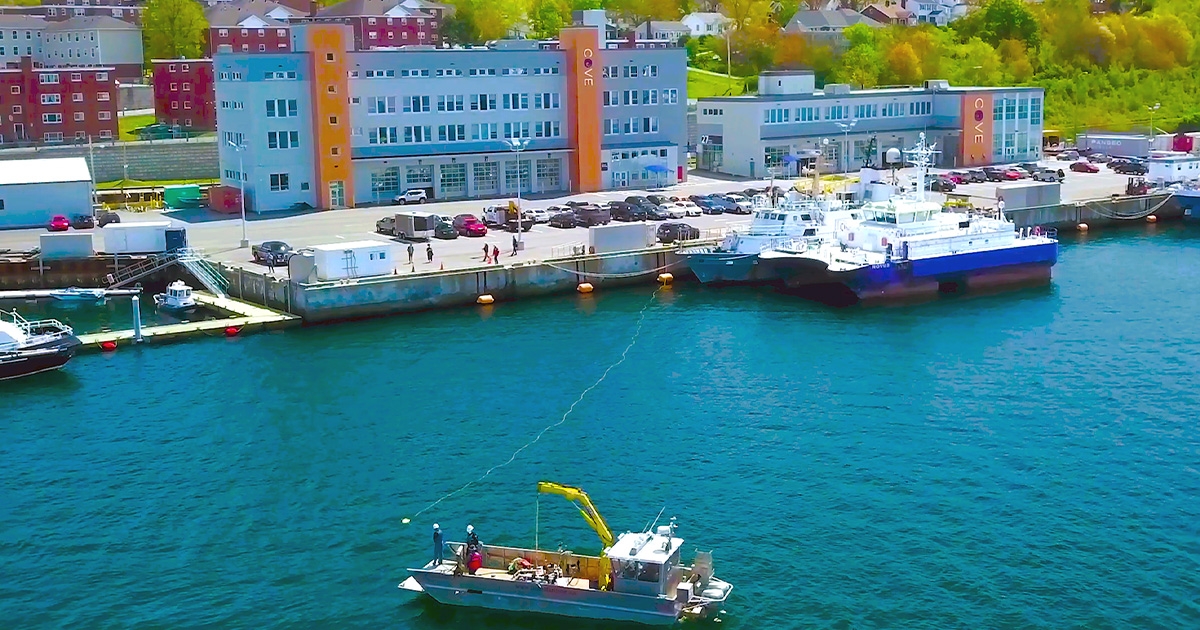The Future of Real-Time Data from Seabed to Space at Cove

The number of Ocean Enterprise companies operating in Canada continues to grow at a pace outperforming our global counterparts. At the heart of this expanding Canadian sector on the shores of the Halifax Harbour is COVE, home to a community of over 60 ocean tech companies that are creating the world’s next practical, commercial, and revolutionary ocean tech advances.
Success at COVE The growth and has been driven by the ability to connect and innovate. Every day, COVE brings people, ideas, resources, and assets together to propel Canada’s, and the world’s, marine technology sector.
STELLA MARIS
In May of 2021, these principles of connection and innovation culminated in the launch of the Stella Maris, a multi-sensor seabed platform capable of holding a wide variety of sensors that collect different oceanographic parameters, developed by a team of top engineers at COVE.
The platform, which sits 10 meters below the surface and 100 meters from COVE’s wharf, functions as an accessible and affordable marine instrumentation testbed for ocean technology companies to conduct product development, verification, and commercialization to get their products to market faster. Users can remotely monitor, control and configure equipment on the platform from the operations center located on the edge of COVE’s wharf. Since first touching down on the ocean floor, the platform has been a source of collaboration, with many tenants at COVE relying on data from other sensors to help support their own.
The opportunities for collaboration also extend beyond COVE’s physical location. Stella Maris has the capability to allow companies to put sensors on the platform and receive real-time data from wherever they are in the world, something that has grown international interest.
Although COVE is proud to look back at the early success of Stella Maris, the focus is now on looking to the future.
Through Stella Maris, we have seen the ability to collaborate varying data parameters and sets into an interface that displays them. While today this is on a smaller scale with a single platform, COVE is thinking bigger.
Knowledge of the ocean, its health, and its activities are crucial to the successful operation of naval, commercial, and research vessels, and in turn, to international security and economic stability. The trifecta of environmental, safety and economic concerns are exacerbated in ports, where a high concentration of marine activities mandates sound decision-making while minimizing uncertainty. Connecting port users of all backgrounds with good information in a timely fashion is of primary importance.
DATA DEMOCRATIZATION
COVE’s Digital Harbour: Seabed to Space is a collaborative initiative that will digitally monitor Halifax Harbour with an integrated system incorporating real-time data sources from stationary and mobile infrastructure located in the water, on land, in the air, and via satellite.
Digital Harbour’s objective is to collect large longitudinal and spatial datasets of key metrics to create solutions for a multitude of users in both the public and private sectors.
Having data collaboration can provide a wide variety of benefits to all port users, both private and public. It can improve port safety and the efficiency of vessel travel, saving both costs and lives in the process. It allows for new technologies to reach the market faster as their impacts will be more closely understood, driving business and economic growth.
Finally, close monitoring of the environmental factors and port health allows for both public and private actors to make the most advantageous actions for port and ocean longevity for generations to come.
Digital Harbour will also detect the presence of biological species used for eDNA purposes and fish and marine mammal movement, for example, through optical and acoustic sensors, all marine activity, including vessel movements, can be better understood in real time.
The data collected from these diverse sources will be hosted on a centralized platform and will allow companies to develop visualization and interpretation tools that will benefit naval, industry, and research-focused end-users by providing all-domain situational awareness, commercial opportunities, and improved predictive modelling techniques.
Throughout this process, previously used data will be given new relevance in helping classify trends and changes over time. In all, Digital Harbour creates the foundation for the ocean data ecosystem to notably enrich data collaboration, access to information, data processing tools, and technology development in the industry.
CENTER FOR INNOVATION
The ability to grow the ocean economy requires a concerted effort to radically progress how we harvest food, generate energy, transport goods, provide services, and transform legacy industries to a more digitized mode of operation. The Digital Harbour is responding to this challenge and creating a scalable, global solution to digitize the ocean for commercial value in an environmentally sustainable way.
Undoubtedly, this is a major undertaking. There are only a handful of regions in the world with a dense enough cluster of aerospace and ocean companies to create a similar type of platform and data infrastructure; that is if they were able to coordinate and justify such a project.
Halifax Harbour is a prototypical mid-size port with naval, commercial, research and recreational activities in a constrained physical harbor space. Located in a province that is home to 31% of Canada’s ocean enterprise companies, it is an ideal location to demonstrate an all-domain situational awareness network.
The ability to cost-effectively monitor marine areas and deliver commercially relevant data-based solutions is desirable to several regions around the world. With a successful deployment in the Halifax Harbour, led by global ocean tech leaders at COVE, Digital Harbour will revolutionize industry-centered global ocean sensing and ocean data applications.
For more information, visit: www.coveocean.com.
This feature originally appeared in Ocean News & Technology's Magazine December 2022 edition. To read more, access the magazine here.

